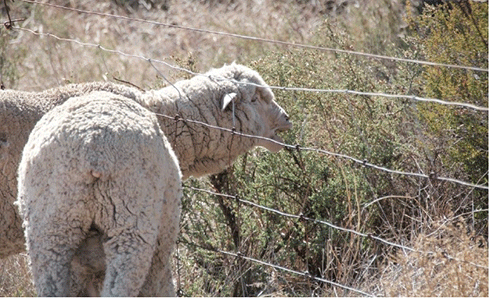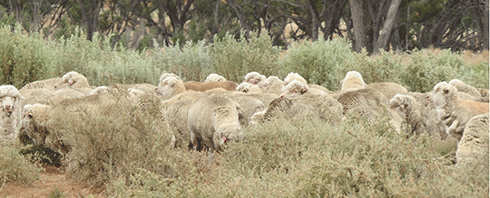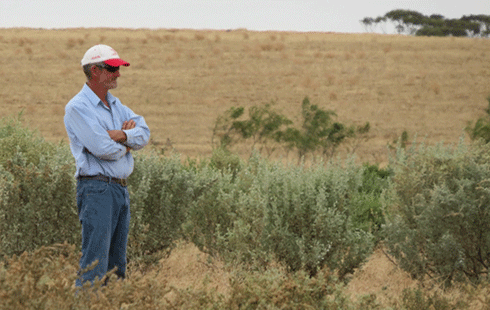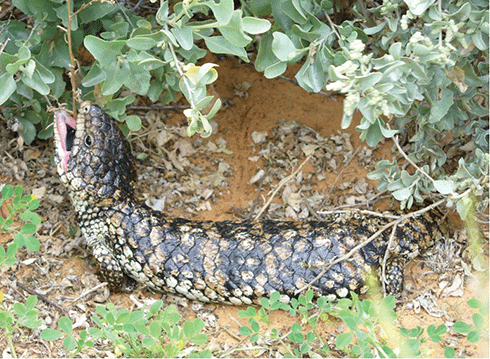
|
Published: 23 April 2014
Sheep know best: shrub selection and the wisdom of the flock
As a livestock crop, perennials – especially native shrubs such as species of saltbush – not only capture rainfall all year round, but also sequester more carbon over time than crops or pastures that contain only annuals. But what do the livestock think?

|
|
Grazing preferences of livestock were observed to develop more resilient farm management approaches that allow animals to graze a mixture of native forage shrubs. Credit: Dean Revell, CSIRO
|
‘Let us permit nature to have her way, she understands her business better than we do’ . It comes as a surprise to see the words of Michel de Montaigne – a maverick 16th century French philosopher – in a 21st century booklet on Australian shrub-based perennial grazing systems. Yet there is a touch of unconventionality about the long-running ‘Enrich’ research project which the booklet documents.
Enrich was carried out through the Future Farm Industries CRC, a cooperative research group dedicated to exploring the potential of perennial plants in southern Australia’s dryland farming systems.
Since 2004, Enrich researchers have been conducting plant selection and farm trials to assess the potential contribution of native perennial shrubs such as saltbush (Atriplex species) to profitability and resilience of livestock grazing, particularly in low-medium rainfall areas and on agriculturally marginal soils such saline and sandy soils. The project, which concludes in June 2014, won the inaugural 2013 Eureka prize for sustainable agriculture.
Complexity is key
Saltbush has been planted as sheep forage in salt-affected soils in parts of southern Australia since the 1980s, although not on a significant scale. The shrubs are generally grazed during the autumn feed gap, when annual pastures are dead and of poor nutritional value.
Enrich project leader, Dr Jason Emms, says that while research aimed at improving the resilience and profitability of forage shrub systems is not new, Enrich has broken the mould in a number of ways.
First, Enrich never set out to find a ‘silver bullet’.
‘Usually it’s all about picking a winner,’ says Dr Emms. ‘You would initially focus on a lot of species, and then try to narrow down to one, the best one.
‘We never set out to do that. We started with the hypothesis that a combination of plants is going to be a better balanced diet for the animal than just relying on one species. If we just ate potatoes all the time we could survive but we won’t thrive. Similarly with animals and their diet, you can’t expect them to do well on one plant species.’
The Enrich project began with 101 species, selected on the grounds that they were perennial, palatable, had a woody growth form, and were native to the livestock-cropping zone (temperate) or southern-pastoral zone (semi-arid). A few exotic species were included for comparison. These were then narrowed down to a subset of 10 species with the most potential.
‘The way we evaluated plants and their potential in grazing systems was also different,’ says Dr Emms. ‘Instead of just focusing on the usual stuff – protein, energy, fibre – we also asked what other roles forage plants play in terms of animal health and digestive efficiency.’
In sheep and cattle, digestive efficiency – the extent to which the animal is able to extract energy from the plant – is largely governed by fermentation by microbes in the rumen (the first stomach). Methane is one of the waste products of rumen fermentation and represents a loss of energy from the animal. It also has greenhouse gas implications.
On Greg Richards’s cropping and grazing property at Quairading in south-west Western Australia, neighbouring farmers were intrigued when a large inflatable polytunnel appeared on the property. This was the first on-farm use in Australia of this method of measuring methane production from livestock. Sheep are brought straight in off the shrub forage system and placed in the polytunnel, where the change in atmospheric composition in the tunnel is measured.
Among the top performers for reduced methane emissions is Eremophila glabra (tar bush). It is indigenous to most of Australia south of the tropic of Capricorn but not does occur in Tasmania and south eastern Victoria.
Mr Richards’s farm has approximately 400 ha of salt-affected land on it and the trial paddock was sited on this land. It was planted with a mixture of species: old man saltbush, river saltbush, ruby saltbush, tar bush and rhagodia.
‘It’s given me the ability to graze the salt lands that I would not have been able to use at all otherwise,’ says Mr Richards.
‘I would be hand-feeding those animals [in autumn] if it weren’t for the trial. The sheep will reduce the plants to sticks, and then I’ll take them off the trial plots.’
Learning new choices
According to Dr Emms, one of the aims of Enrich was to challenge conventional wisdom regarding the viability of mixtures of forage shrubs from the point of view of livestock grazing behaviour.
‘People say “Oh, that doesn’t work because they will just focus on one and eat that out.”
‘We hypothesised that grazing management based on animal behaviour was going to be key. So we used techniques aimed at assisting the livestock to make diet selections that would allow them to graze these mixtures.
‘We found that experience is really important – getting the animals familiar with the plants on offer had a big impact. A practical way to apply this is to use temporary electric fencing, enclosing small areas, moved throughout the shrub block over a couple of weeks, to give the animals repeated exposures to fresh plots.’
Experiments conducted by CSIRO researchers Dr Dean Revell and Dr Hayley Norman also reveal that the influence of mothers on their offsprings’ foraging behaviour isn’t restricted to lambs at foot but starts in utero.
‘Lambs that had mothers eating saltbush before they were born performed better on saltbush and were more selective on the saltbush,’ says Dr Emms.
‘And the use of older animals is important, so using a few older, experienced animals in a mob allows peer-on-peer learning.’

|
|
Sheep graze native shrubs on an ‘Enrich’ trial paddock at Greg Richards’s farm. Credit: Jean Burton, Future Farm Industries CRC
|
More sustainable soil and water use
As well as offering profitability and resilience benefits, increasing the perennial component of farming systems – the broader goal of the Future Farm Industries CRC – also helps protects farming’s natural resource base: the health of the soils and water on which our farms depend.
CSIRO researcher Dr Rick Llewellyn heads up EverCrop, a related Future Farm CRC research program that focuses on incorporating perennial forages in southern Australia’s annual plant-based cropping systems (mixed grazing and cropping enterprises).
‘Many of the soils we have worked with in Western Australia and in the Mallee in South Australia and Victoria are prone to erosion that is partly due to the lack of groundcover over the late summer-autumn period when annual pastures die off,’ says Dr Llewellyn.
‘So perennials present a good opportunity to help farmers reduce erosion risks and at the same time allow grazing.’
On salt-affected land the shrubs, which are more deep-rooted than annual pasture, can lower the level of saline water tables below the root depth of inter-row annual pasture.
Ian Walsh owns a cropping and grazing property at Cranbrook in south-west Western Australia and has participated in the Enrich program. Forage shrubs were planted on an area of his land that used to have a very shallow water table half a metre below the surface and included bare salt scalds.
‘The water table is now 2.5 metres [below] and the scald is gone,’ says Mr Walsh.
‘We’ve been able to carry on our salt land, or our water-logged country as I prefer to call it, a similar carrying capacity [ie livestock per hectare] to what we can have on our better pastures.’
Biodiversity benefits
Another related Future Farm CRC research program, Productive perennials for biodiversity, has explored at the contribution that productive woody perennials can make to biodiversity conservation in farming landscapes.
At a recent Future Farm CRC forum in Canberra, program leader Dr Ken Wallace, from the Western Australian Department of Parks and Wildlife, noted that while it is clear saltbush provides habitat for a range of bird and reptile species, planting perennials should not be seen as substitute for protecting existing remnant vegetation in the landscape.
‘The thing I’d want to emphasise out of this particular project is that although the mallees and the saltbush provide important habitat for some species of native fauna, the gold standard is the remnant native vegetation,’ says Dr Wallace.
‘A far greater variety of species will inhabit the native vegetation. So we can see that the perennials we might put in the landscape as bolstering particular resources, but they’re really no substitute for the remnant vegetation we need to protect in the landscape.’
Dr Emms is clear about where he thinks follow-up research should go.
‘We need to get a lower cost of establishment because it’s a big barrier to adoption. Even though forage shrubs are profitable and have a lot of benefits and the payback period is long – because the shrubs live a long time – the upfront costs are prohibitive to a lot of people getting started.
‘A lot of the saltbush that got planted 20 years ago in the decade of Landcare was subsidised and a lot of those subsidy programs have gone.’
But as Dr Emms points out, incentive schemes aren’t necessarily the answer, given their unreliability with changing policy environments. Shrub establishment is currently done with tube stock, grown out by commercial nurseries, an expensive exercise. The development of cost-effective direct seeding methods might be a promising avenue of research.
You can watch Future Farm Industries CRC’s video on Enrich here.





